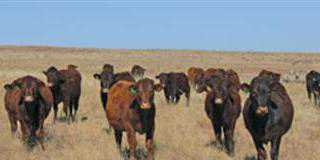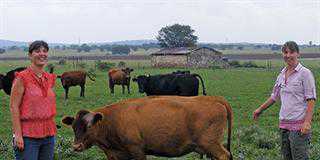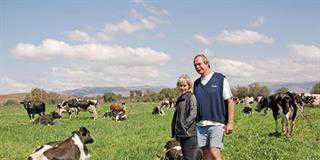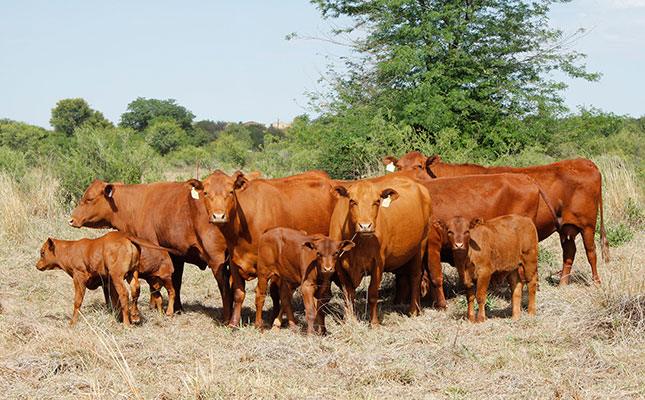
Photo: Wayne Southwood
The Senepol is a two-breed composite developed on the Caribbean island of St Croix. The two breeds are the N’Dama, a beef cattle breed native to Senegal in West Africa, and the Red Poll.
The first Senepols were bred by Bromley Nelthropp in 1918 with the aim of developing a breed of cattle that would flourish in the island’s tropical environment and combine the traits needed for top production.
The first Senepol arrived in South Africa in 2001 following the formation of the SA Senepol Club under the auspices of the Red Poll Cattle Breeders’ Society of SA in 2000.
“The breed’s popularity increased to such an extent that it can now be found in most provinces of South Africa and in neighbouring countries such as Botswana and Namibia,” says Wilhelm.
His Joxepa stud forms part of the Bothaville-based SF Haasbroek Farming family enterprise, which produces grain, sheep and cattle. The herd is run on 1 480ha.
Wilhelm considers the breed ideally suited to the extensive beef production conditions of the western Free State where the temperatures range from below zero in winter to the high 30s in summer.
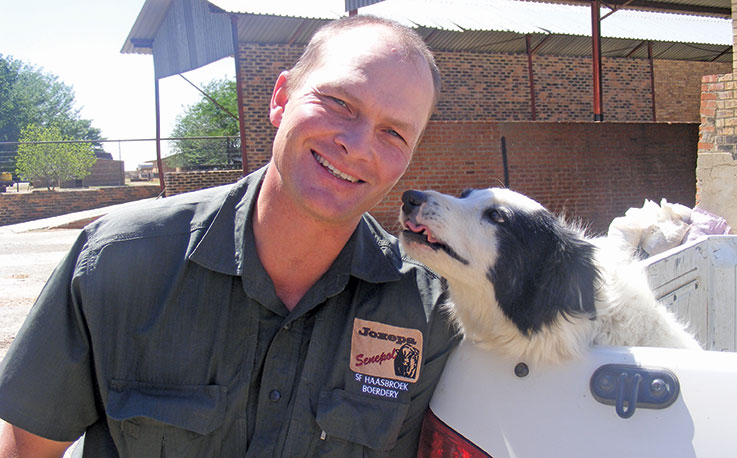
“The Senepol’s genetic composition from two Bos taurus breeds has resulted in an efficient animal that’s ideal for crossbreeding,” he says.
“It’s one of the very few Bos taurus breeds with the heat tolerance necessary to excel in hot regions. Its short red coat contributes to this: Senepol cattle don’t normally seek shade during the midday heat. And it has been estimated that they graze around 1,25 hours longer per day than most other Bos taurus breeds.”
In mid-summer, Wilhelm explains, rosette-like patterns appear on the back of the animal, an indication of the efficient sweat glands that reduce the body temperature.
The stud
Wilhelm established the Joxepa Senepol Stud in 2008 when he leased a bull from another breeder with the arrangement that he would return 10% of its progeny to the owner.
This agreement extended to two bulls the following year. He eventually bought one of these bulls but continued to lease the other one.
This arrangement worked so well that he entered into an embryo programme with another breeder. Wilhelm supplied the recipient cows and the other breeder provided the genetics. The first calves were born in October 2011.
Recently, he transferred in vitro-fertilised embryos from three donor-cows to 50 recipient cows with imported semen from the Nova Vida Senepol stud in the US and using the bulls PRR 7013 and RBS 9704G.
Breeding
The naturally polled Senepol is known for exceptional fertility, says Wilhelm. The cows have a calm temperament, outstanding maternal abilities and produce enough milk to wean calves at 40% to 50% of their own weight. Wilhelm follows a single, 63-day multi-sire breeding season starting on 15 January each year.
He uses one bull for every 25 to 40 cows and determines paternity through DNA testing. Every cow has to wean a calf every year; if it fails to do so, it is immediately culled from the herd.The Senepol is the ideal breed for crossbreeding, according to Wilhelm.
When bred to horned breeds, its prepotency for this characteristic has ensured that 90% of the progeny are also polled.
Senepol cattle mature early, so heifers can calve at two years. Joxepa heifers are mated at 15 months and expected to drop their first calves at 24 months.
About half of the 350-strong (300 cows and 50 heifers) registered breeding herd are artificially inseminated every year, usually in the first week of January. Their oestrus cycles are synchronised to allow Wilhelm five days to complete the process.
“We also use AI to bring new genetics into the herd, sourcing semen locally and from the US and Australia,” he explains.
“My objective is to breed well-adapted animals that excel on the veld and produce top-quality beef from relatively low-quality forage.”
Grazing
The cattle uses 45 grazing camps, each with a watering point. The sandy loam soil is dominated by red grass (Themeda triandra) and Smuts finger grass (Digitaria eriantha).
The average rainfall is between 300mm and 500mm. Sound veld conservation and management are important to Wilhelm. Half of the grazing land is rested for a full year, with the other being grazed from 1 August to 31 July.
The animals are rotated every 60 days in the portion being grazed. The forage resource includes a mixed pasture of 60ha irrigated Smuts finger grass and tall fescue (Festuca arundinacea).
A phosphate lick, mixed according to Wilhelm’s own recipe and containing trace elements, salt and protein, is provided in summer. He supplies a protein lick in winter, while heifers receive a production lick from weaning until being mated at 15 months.
“We ultimately farm with grass and convert it into beef,” he explains.
“This programme allowed me to keep the herd on the veld, even during the past three years’ drought in the Free State. But given the current conditions, I may have to supply additional feed if it doesn’t rain soon. We’re fortunate that I can make silage, should we need it.
“I also wean calves at five months instead of seven months to allow the cows some respite.”
The basis of Wilhelm’s stud breeding is animal recording and performance testing. The Joxepa herd was lauded as Senepol Herd of the Year, and Wilhelm’s detailed record-keeping played a part in this, says Senepol SA secretary Charmaine Butler.
Statistics show that the stud maintains an inter-calving period of 425 days. The breed is known for easy calving and low birth weights. The average Joxepa birth weight is 35kg with an average seven-month weaning weight of 250kg for bull calves and 230kg for heifers.
The short, fine coat ensures that the medium-framed Senepol carries few external parasites. Research by the US Department of Agriculture shows that Senepol cattle have a high general immunity to disease. This is ascribed to the N’Dama influence and the selection applied in the development of the breed. Moreover, the cattle rarely experience pink eye or cancer of the eye.
The Joxepa herd is inoculated against blackleg, Rift Valley fever, lumpy skin disease, botulism and anthrax shortly before summer.
In the past, jackals were a threat during the calving season but Wilhelm has contained the problem since introducing guard donkeys three years ago.
Plans to own value chain
Senepol beef is of exceptional quality and Wilhelm supplies the Local Grill restaurant in Johannesburg. His ultimate goal is to take ownership of the beef value chain and he plans to build an on-farm abattoir and deboning facility.
“My Senepol beef received very good reviews,” he says.
“It’s early days yet, but the input costs of red meat production are so high that we as primary producers will have to get involved in the value chain to ensure long-term sustainability and profitability.”
Phone Wilhelm Oosthuyzen on 082 611 7766 or email him at [email protected].











